and Mark C. Mammel2, 3
(1)
Division of Neonatal-Perinatal Medicine, C.S. Mott Children’s Hospital University of Michigan Health System, Ann Arbor, MI, USA
(2)
Neonatal Medicine, Children’s Hospitals and Clinics of Minnesota, St. Paul, St. Paul, MN, USA
(3)
University of Minnesota, Minneapolis, MN, USA
Keywords
Clinical case managementRespiratory distress syndromeSynchronized intermittent mandatory ventilationAssist/control ventilationContinuous positive airway pressureTidal volumeBronchopulmonary dysplasia7.1 Case 1
A 29-week, 1,250-g male, is now 24 h old. He has received three doses of surfactant. The current ventilator settings are synchronized intermittent mandatory ventilation (SIMV) with a rate of 30; peak inspiratory pressure (PIP) 26; positive end-expiratory pressure (PEEP) 4; inspiratory time (Ti) 0.35 s; and fraction of inspired oxygen (FiO2) 0.55. The spontaneous respiratory rate (RR) is 75. Arterial blood gas (ABG): pH 7.21; partial pressure of carbon dioxide (PCO2) 62; and partial pressure of oxygen (PO2) 50. The measured tidal volume (Vt) varies from 2 to 5 mL/kg. The graphics are shown in Fig. 7.1 (showing the two populations of breaths during SIMV, mechanical and spontaneous).
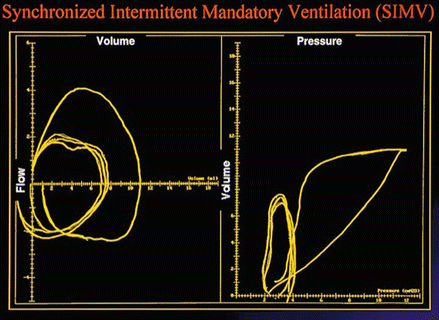

Figure 7.1
Case 1 (Note that this monitor draws the F-V loop reversed and inverted compared to previous examples)
Which of these is the best choice under the circumstances?
(a)
No changes needed, recheck ABG in 2 h
(b)
Increase ventilator rate to 60, increase PEEP to 6, increase PIP to 28
(c)
Switch to assist/control ventilation (A/C) mode, rate 40, add volume targeting with inspiratory pressure limit 30 (to yield 4–6 mL/kg Vt), increase PEEP to 6
(d)
Switch to high-frequency oscillation (HFO), rate 12 Hz, and adjust the amplitude for adequate chest wiggle
(e)
Switch to continuous positive airway pressure (CPAP) at 6 with pressure support ventilation (PSV) of 20
Answer:
(c) Switch to A/C mode, rate 40, add volume targeting with inspiratory pressure limit 30 (to yield 4–6 mL/kg Vt), increase PEEP to 6
This infant is showing the effects of inadequate respiratory support. His supported breaths have adequate Vt, but his spontaneous breaths do not and are too small, thus resulting in tachypnea. His lung volume also is inadequately supported; the persistently high FiO2 after surfactant indicates inadequate mean airway pressure (Paw). The A/C mode provides support for all breaths, with the rate of 40 providing apnea protection and the pressure limit allowing the pressure to vary based on Vt. The higher PEEP will begin the recruitment process. Increasing the SIMV rate may address the problem but still has the potential for either too much or too little support. HFO is not needed here, and CPAP with PSV does not protect against apnea or allow volume targeting.
7.2 Case 2
A 700-g female is now 10 days old and is receiving A/C at a control rate of 40 (spontaneous rate, 60); Ti 0.2 s; volume target, 4–6 mL/kg; inspiratory pressure limit set at 28; PEEP 6; FiO2 0.35. The low-volume and high-pressure alarms are sounding. The most recent ABG: pH 7.21; PCO2 60; PO2 55; oxygen saturation in arterial blood (SaO2) 93 %. The current graphic screen is shown in Fig. 7.2.
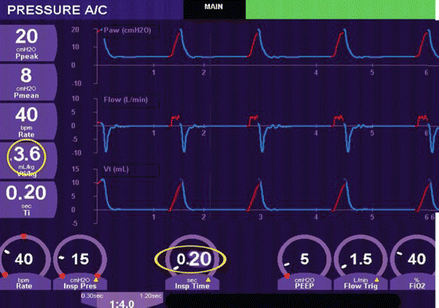

Figure 7.2
Case 2
Which of these represents the best choice?
(a)
Increase RR to 60
(b)
Switch to HFO, 15 Hz, amplitude adjusted for wiggle
(c)
Switch to high-frequency jet ventilation (HFJV), with mean Paw of 2 cm H2O above = conventional mechanical ventilation (CMV), PIP 28
(d)
Evaluate the inspiratory gas flow waveform
(e)
Increase the PIP limit to allow higher Vt
Answer:
(d) Evaluate the inspiratory gas flow waveform
The problem here is inadequate Vt delivery, evidenced by tachypnea, low-Vt/high-pressure alarms, and respiratory acidosis. The likely culprit is a Ti that is too short. In flow-cycled A/C, Ti is a limit variable, that is, the longest allowed time. This baby’s time constants do not allow enough gas flow in the 0.2 s, so PIP increases in an to attempt to move gas (and, hence, volume) faster. The flow waveform will show this and also will show the immediate improvement with a longer Ti. Fig. 7.3 shows the impact of this change.
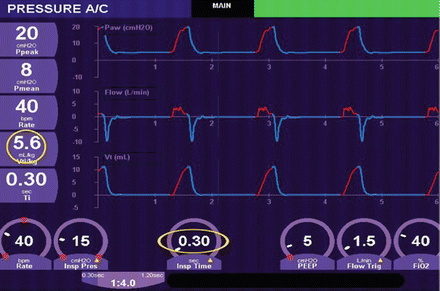

Figure 7.3
Case 2
7.3 Case 3
A 6-day-old female born at 26 weeks has been relatively stable receiving A/C with volume targeting. The nurse calls you to the bedside because the ventilator is alarming “high pressure.” Vt is 2.5 mL/kg even though the PIP is 30 cm H2O, the maximum allowed. Previous pressure requirements had been in the 20–22 cm H2O range.
Which is your best response?
(a)
You obtain a chest radiograph to look for a pneumothorax
(b)
You look at the Vt waveform and pressure-volume (P-V) loop to compare inspiratory and expiratory volumes
(c)
You order an extra dose of surfactant
(d)
You switch to HFJV
(e)
You request a more experienced respiratory therapist
Answer:
(b) You look at the Vt tracing and P-V loop to compare inspiratory and expiratory volumes
The issue here is the low Vt in spite of high PIP. Either the lung is suddenly stiffer or there is a leak preventing all of the gas from reaching the alveoli. The graphics show higher inspiratory versus expiratory volumes—evidence of air leak (Fig. 7.4). A chest radiograph may be helpful, but is not the solution; additional surfactant will not help either. HFJV is probably not needed. Note that, in Fig. 7.5, neither the flow-volume (F-V) nor the pressure-volume (P-V) loop closes, which is indicative of a leak. Try to identify the source of the leak.
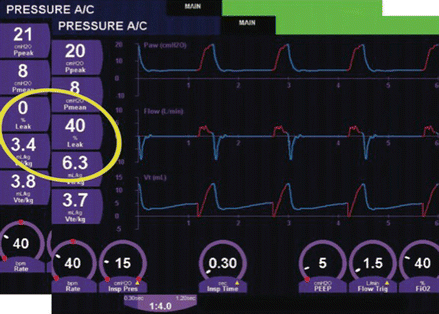
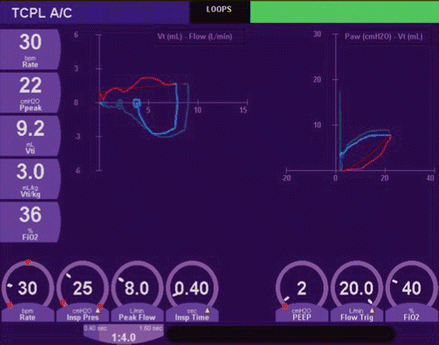

Figure 7.4
Case 3

Figure 7.5
Case 3
7.4 Case 4
A 27-week preterm newborn is intubated shortly after birth and placed on mechanical ventilation. She is transferred to the NICU and placed on mechanical ventilation using pressure control in the A/C mode. The initial waveforms are shown in Fig. 7.6. A dose of surfactant is administered, resulting in the changes shown in Fig. 7.7. The ABG now shows pH 7.46; PCO2 28; and PO2 66.
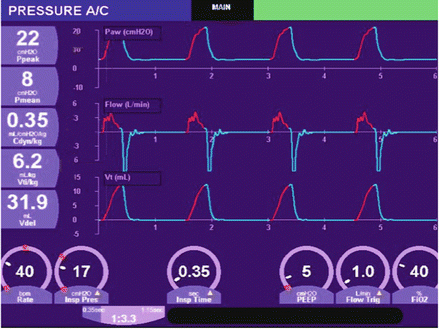
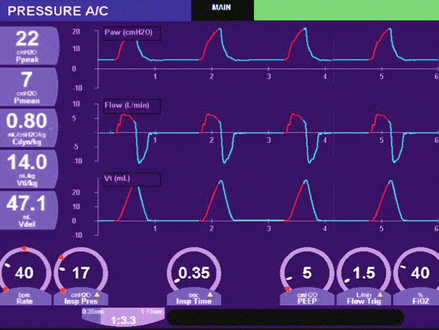
Get Clinical Tree app for offline access


Figure 7.6
Case 4

Figure 7.7
Case 4
Which of the following statements is NOT true?
(a)
There has been a marked improvement in dynamic compliance
(b)



